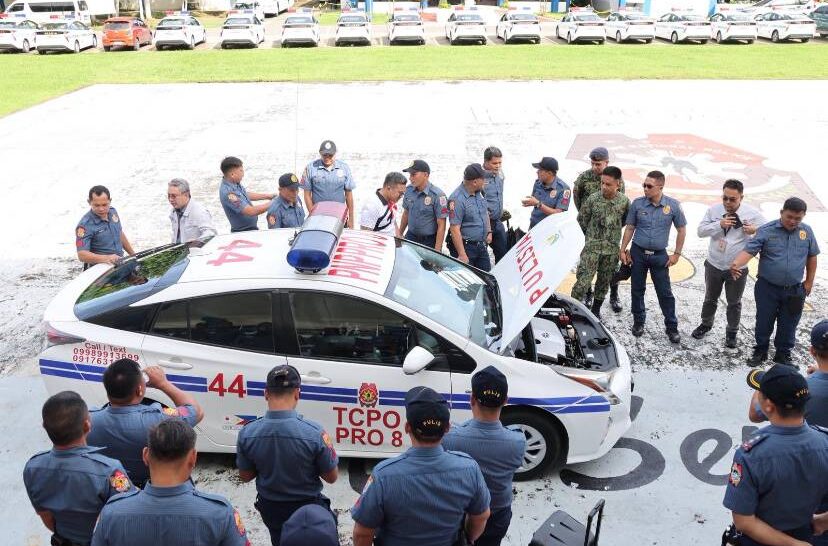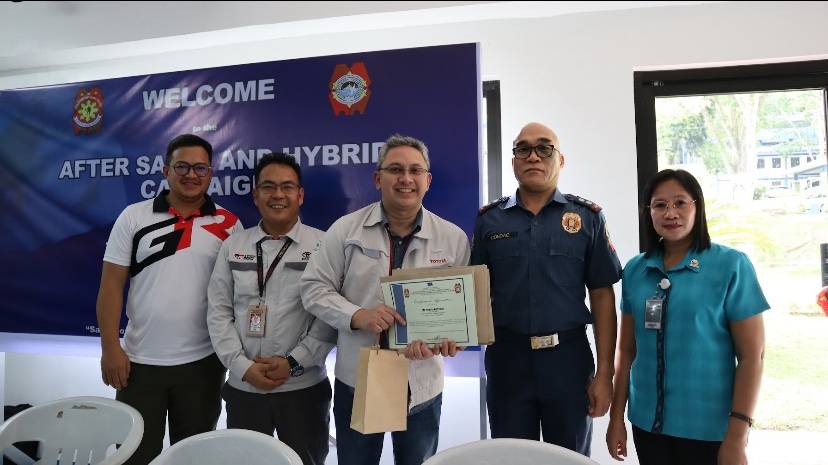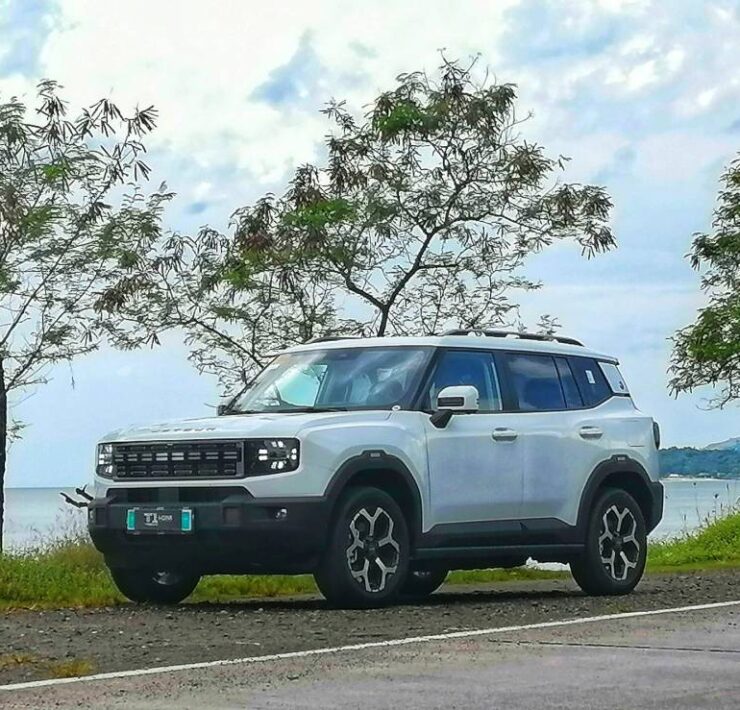The Prius as a low-emission, ‘law-on-a-mission’ squad car

Picture the Toyota Prius in your mind, and imagine how it has been used over the decades: An office exec’s daily driver from home to work; a weekend ride for soccer moms and out-of-towners; a cost-efficient transport for the college student, perhaps.
But as a police car? You know, those cars that need to have massive power under the hood and “oomph” at a moment’s notice, and reliability and toughness to match the bravery of its uniformed occupants…A Prius hybrid fits that bill?
Apparently so, if you ask members of the Philippine National Police (PNP) stationed at Regional Office 8 in Tacloban City in Leyte Province.
They do get their share of the action, as far as keeping the peace and enforcing the law are concerned. They engage in hot pursuits and get the baddies into cuffs. But they do so rather, well, more “quietly” than the usual, especially if the hot pursuit stays just under 40 kph, when the Prius is in pure EV mode.
But when they need to go fast, they get really fast, at speeds that would most likely land them in hot water if it were printed here. They’ve also provided good security cover for visiting VIPs like the two most recent Philippine presidents.

Their Prius squad cars have also saved their skins many times—escaping from ambushes, evading land mines (yes, landmines in sacks placed on the highway. Yikes!), and fleeing from rampaging floods. Talk about living life dangerously. These policemen in Tacloban must be eating stainless steel bars for breakfast. It sure makes that no-show boxing match at Rizal Stadium feel like watching paint dry.
Oh, the stories these policemen in Priuses could tell. They have a ton of tales to unpack, given that as far back as 2017, they were handed 49 Prius units by the Japanese government. Since then, these Priuses have been patrolling Tacloban’s streets 24/7 for 3,131 days (8 years, including leap days in 2020 and 2024) as keepers of the peace and as first responders. No rest for the wicked, so no rest for the quietly vigilant.
These Prius hybrid electric vehicles (HEVs) are 4th-generation variants, and the policemen that have been using them all these years attest to the vehicles’ toughness, responsiveness, adaptability, and yes, speed. Suffice to say, they’ve reached speeds that, if translated to a score in bowling, many-time world champ Paeng Nepomuceno would be very happy with. All in the name of justice, and more importantly, survival.

“We drive the Prius fast, especially in emergencies when we have to avoid possible ambushes and in remote areas in Samar, Southern Leyte and on our way to Ormoc. Yes, landmines, or improvised explosive devices are now being placed inside sacks and placed on the roads in remote areas in Samar and Southern Leyte,” confirmed Police Staff Sergeant Mark Gil S. Mazo, 44, of the Mobile Patrol Unit (MPU) of the PNP Tacloban, in a phone interview with Inquirer Mobility. In at least one incident in the town of Catbalogan, an IED on the sidewalk detonated just as a Toyota Hilux patrol vehicle passed by. Fortunately, there were no fatalities.
These 49 Priuses have patrolled Tacloban and its outskirts so thoroughly and religiously, their odometer readings are well into six figures, averaging around 193,000 km on daily rounds that go for up to 300 km. Mazo’s Prius, in particular, has broken the 300,000-km mark. One unit has even breached the 400,000-km mark. That one must have been in one very long car chase.
That reading is truly remarkable, considering that both men and machines face the harshest of elements—criminal and natural. “Apart from dealing with criminals, we also have to deal with extreme forces of nature; floods being the toughest for us on the road. We already follow the rule of thumb that if the flood is below knee level, it’s still safe for the Prius to drive through, just like any sedan,” explained Mazo.

Mazo and his team respond to calls to their police hotlines. Many times, they have to rush to the scene as a group, together with other peacekeeping agencies such as the SWAT. In such instances, they have to keep up with the pace of other vehicles.
“The Prius is remarkably fast. It’s like a sports car to us. It feels like it hugs the road. In emergencies, we have had to run upwards of 150 kph, in remote, open highways where there are real dangers of ambushes or landmines. Our Prius has a speed warning that sounds an alarm whenever we exceed 120kph,” Mazo revealed. Never has an alarm system felt so useless.
Police Staff Sergeant Christopher Noel Alcaraz, 39, said, “We never drive the Prius slow. We’re always on power mode. You can’t go slow when you’re in hot pursuit. You can’t go slow when a Land Cruiser is tailing you closely when you’re escorting VIPs. We’re always the lead cars in convoys.”
OG batteries still good
Mazo said that the lithium-ion batteries of all 49 Priuses are still being used. The only problem they have to deal with are four ignition coils that need to be replaced. Mazo said these parts can only be sourced from Japan. Otherwise, these hybrids undergo the same maintenance processes and parts replacements ICE-powered cars of the police force are subjected to.
Toyota Japan helped maintain the Priuses in the first five years of operation. Afterwards, the PNP assumed full responsibility for their upkeep.
Mazo and Alcaraz observe that driving a Prius feels like driving a regular internal combustion engine car, the key difference being the hybrid’s fuel efficiency. Toyota’s HEV technology, even in this hybrid, delivers significantly better fuel economy, requiring less trips to the fuel station, which translates to more time spent actually patrolling the roads.

The Priuses of PNP Tacloban present 48 solid pieces of evidence of Toyota’s stellar 30-year track record in hybrid car development. That for 8 uninterrupted years these Priuses have survived, and are still used for hardcore police service, in an area that’s continuously subject to climate and social extremes, leaves no room to doubt the Prius as an all-time game-changer for Toyota.
In fact, the Toyota hybrid system (THS) has enabled the Prius to be among the “50 cars that have changed the world,” according to the Design Museum car book. The Prius’ hybrid system has been the foundational technology behind Toyota’s current crop of HEVs.
The synergy between PNP Tacloban’s police force and their Priuses were acknowledged on June 18 when officers of Toyota Motor Philippines (TMP) visited the Police Regional Office 8 headquarters for a special “goyokiki” activity—the Japanese corporate practice of going onsite and talking to end-users to learn of their experiences and understand their needs.

The activity was led by TMP vice president for CSO service planning and administration Marvin Gardiner, Toyota Tacloban service manager Dave Fenis, and Ritsmond Kalambacal, TMP manager for General Job Technical Training. The visitors were able to inspect 32 Priuses available at the time, while they gathered feedback from the long-term users, who said that the Prius was “very responsive” on Power Mode, “comfortable and reliable for daily use,” had “low cost of ownership,” and “ease of maintenance and service.”
PLTCOL Roderick P. Condag, Acting Chief, RLRDD of PNP, Police Regional Office 8 expressed deep appreciation for the visit: “We sincerely thank TMP for going the extra mile to visit Tacloban and support our personnel. Toyota has never neglected us and continues to provide dependable aftersales service.”
And despite the expected chassis issues due to the area’s rough road conditions—problems that were considered “minor,” all the Priuses on site were good to go for the coming days—keeping the peace, upholding the law.
As quietly—and as fast—as can be.




















